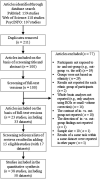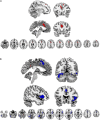Ethnicity, minority status, and inter-group bias: A systematic meta-analysis on fMRI studies
- PMID: 36684846
- PMCID: PMC9852837
- DOI: 10.3389/fnhum.2022.1072345
Ethnicity, minority status, and inter-group bias: A systematic meta-analysis on fMRI studies
Abstract
Introduction: This meta-analysis investigated (1) whether ethnic minority and majority members have a neural inter-group bias toward each other, and (2) whether various ethnic groups (i.e., White, Black, and Asian) are processed in the brain differently by the other respective ethnicities.
Methods: A systematic coordinate-based meta-analysis of functional magnetic resonance imaging (fMRI) studies was conducted using Web of Science, PubMed, and PsycINFO (altogether 50 datasets, n = 1211, 50.1% female).
Results: We found that ethnic minority members did not show any signs of neural inter-group bias (e.g., no majority-group derogation). Ethnic majority members, in turn, expressed biased responses toward minority (vs. majority) members in frontal, parietal, temporal, and occipital regions that are known to be involved in e.g., facial processing, attention, and perspective-taking. We also found differences in neural response patterns toward different ethnic groups (White, Black, and Asian); broadest biases in neural response patterns were evident toward Black individuals (in non-Black individuals). Heterogeneity was mostly minor or low.
Discussion: Overall, the findings increase understanding of neural processes involved in ethnicity perception and cognition as well as ethnic prejudices and discrimination. This meta-analysis provides explanations for previous behavioral reports on ethnic discrimination toward minority groups.
Keywords: BOLD; ethnic; in-group bias; neural; prejudice; racial bias.
Copyright © 2023 Saarinen, Keltikangas-Järvinen and Ravaja.
Conflict of interest statement
The authors declare that the research was conducted in the absence of any commercial or financial relationships that could be construed as a potential conflict of interest.
Figures



Similar articles
-
Neural basis of in-group bias and prejudices: A systematic meta-analysis.Neurosci Biobehav Rev. 2021 Dec;131:1214-1227. doi: 10.1016/j.neubiorev.2021.10.027. Epub 2021 Oct 29. Neurosci Biobehav Rev. 2021. PMID: 34715150 Review.
-
Racial and Ethnic Disparities in Primary Open-Angle Glaucoma Clinical Trials: A Systematic Review and Meta-analysis.JAMA Netw Open. 2021 May 3;4(5):e218348. doi: 10.1001/jamanetworkopen.2021.8348. JAMA Netw Open. 2021. PMID: 34003274 Free PMC article.
-
Ethnic inequalities in the incidence of diagnosis of severe mental illness in England: a systematic review and new meta-analyses for non-affective and affective psychoses.Soc Psychiatry Psychiatr Epidemiol. 2019 Nov;54(11):1311-1323. doi: 10.1007/s00127-019-01758-y. Epub 2019 Sep 3. Soc Psychiatry Psychiatr Epidemiol. 2019. PMID: 31482194
-
Cross-ethnic friendships, perceived discrimination, and their effects on ethnic activism over time: a longitudinal investigation of three ethnic minority groups.Br J Soc Psychol. 2012 Jun;51(2):257-72. doi: 10.1111/j.2044-8309.2011.02050.x. Epub 2011 Sep 5. Br J Soc Psychol. 2012. PMID: 21895704
-
Is ethnic prejudice declining in Britain? Change in social distance attitudes among ethnic majority and minority Britons.Br J Sociol. 2017 Sep;68(3):410-434. doi: 10.1111/1468-4446.12250. Epub 2017 Apr 29. Br J Sociol. 2017. PMID: 28462536
Cited by
-
Attitudes towards Receiving Monkeypox Vaccination: A Systematic Review and Meta-Analysis.Vaccines (Basel). 2023 Dec 12;11(12):1840. doi: 10.3390/vaccines11121840. Vaccines (Basel). 2023. PMID: 38140243 Free PMC article. Review.
References
-
- Abrams D., Rutland A., Cameron L., Marques J. M. (2003). The development of subjective group dynamics: When in-group bias gets specific. Br. J. Dev. Psychol. 21 155–176.
-
- Albajes-Eizagirre A., Solanes A., Vieta E., Radua J. (2019). Voxel-based meta-analysis via permutation of subject images (PSI): Theory and implementation for SDM. Neuroimage 186 174–184. - PubMed
-
- Amodio D. M. (2014). The neuroscience of prejudice and stereotyping. Nat. Rev. Neurosci. 15 670–682. - PubMed
-
- Aron A. R., Fletcher P. C., Bullmore E. T., Sahakian B. J., Robbins T. W. (2003). Stop-signal inhibition disrupted by damage to right inferior frontal gyrus in humans. Nat. Neurosci. 6 115–116. - PubMed
Publication types
LinkOut - more resources
Full Text Sources

